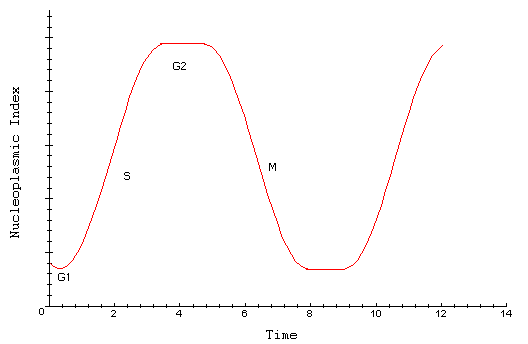
NUCLEOPLASMIC INDEX
Introduction: As cells pass through the cell cycle, their nuclear volume doubles in preparation for division into two daughter cells. When cells are in resting condition, however, the ratio of nuclear volume to cytoplasmic volume remains stable. This ratio is known as the nucleoplasmic index.
Importance: The nucleoplasmic index is considered to be closely related to the mitotic cellular cycle and to the functional phase of cells. It is also a good indicator of dynamic changes in cells. For example, after lizard tails are amputated, spinal nerves, which do not undergo division, might be expected to experience changes in volume to supply the regenerating tail.
Questions: How does the nucleoplasmic index change with the cell cycle? What can the nucleoplasmic index tell us about changes spinal nerves experience when lizard tails are regenerating?
Variables:
|
NP |
nucleoplasmic index |
|
Vn |
nuclear volume (micrometer3) |
|
Vc |
total cell volume (micrometer3) |
Method: The nucleoplasmic index (NP) is expressed mathematically as

where Vn is the nuclear volume and Vc is the total cell volume. When NP is plotted over time, we can see how the ratio of nuclear to cytoplasmic volume changes with the cell cycle.

Interpretation: During the G1-phase, the cell is in a resting state, and the nucleoplasmic index is stable. During the S-phase of the cell cycle, DNA replicates. Consequently, one expects to see an increase in NP as the nuclear volume increases. During the G2 phase, the cell is again stable, although the nuclear volume is now doubled. After mitosis, when the cell divides, NP returns to normal as each daughter cell enters the resting stage, G1. The nucleoplasmic index increases and decreases again as the cell cycle continues.
Method: To determine if lizard spinal nerves experience changes after lizard tails are amputated, the nucleoplasmic index can be calculated for spinal cells supplying the cervical, thoracic, lumbar, and caudal regions of the lizard.

Interpretation: After amputation of a lizard's tail, the nucleoplasmic index for spinal nerves supplying the upper and middle regions of the lizard did not change significantly. However, spinal nerves supplying regenerating lizard tails (in the caudal region) experienced a decrease in the nucleoplasmic index. The lower nucleoplasmic index indicates regenerating tails are innervated by spinal nerves that increase in volume to compensate for the missing tail.
Conclusions: The nucleoplasmic index can indicate changes in nuclear volume over time in cells divide. Additionally, the index reveals dramatic changes in cell volume in response to a stimulus.
Source: Borrione, P., L. Fabiani, S. Geuna, M. G. Giacobini-Robecchi. 1997. Nucleo-plasmic index variability in dorsal root ganglion neurons of the lizard (Podarcis sicula) during neuronal hypertropy. Neuroscience Letters 233:1-4
Copyright 1999 M. Beals, L. Gross, S. Harrell